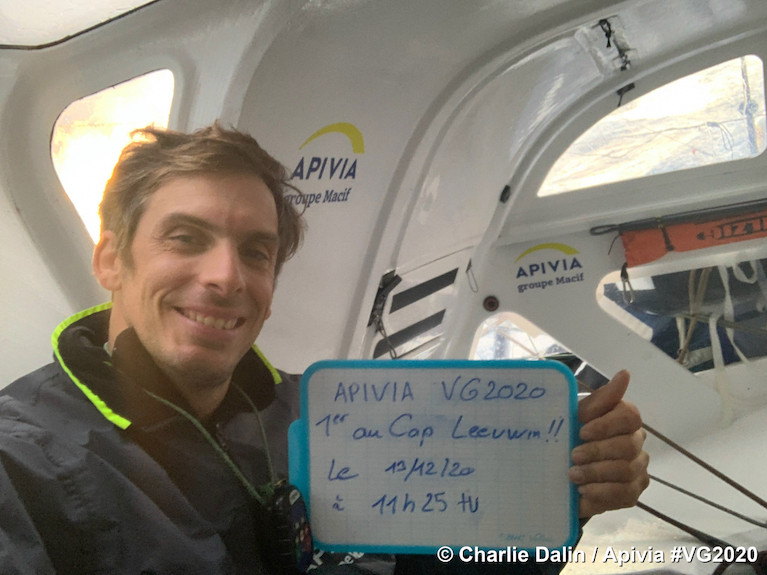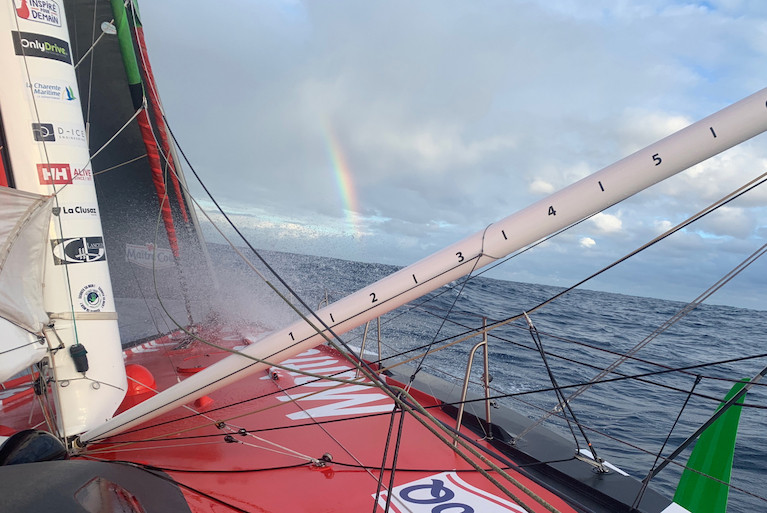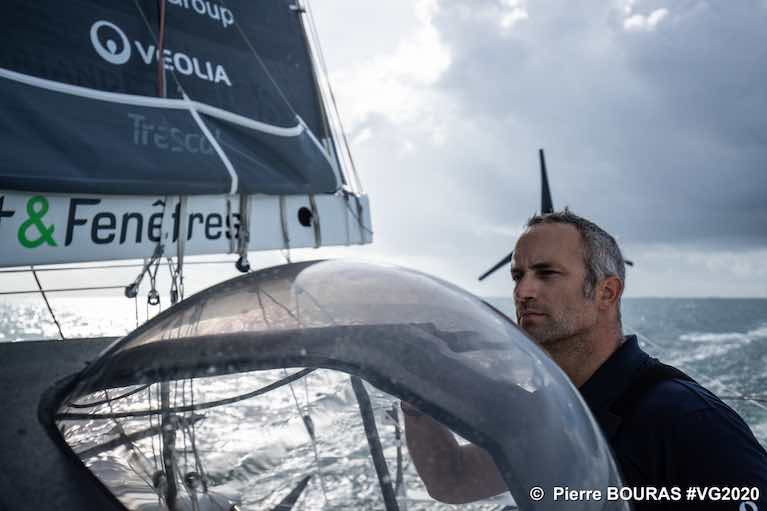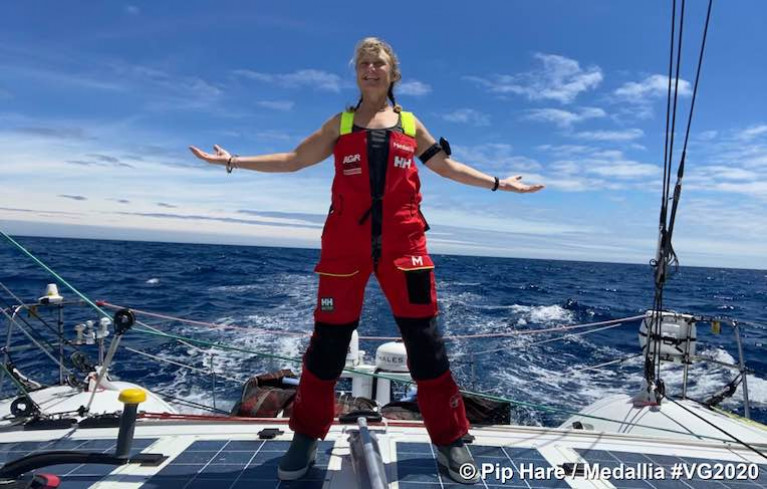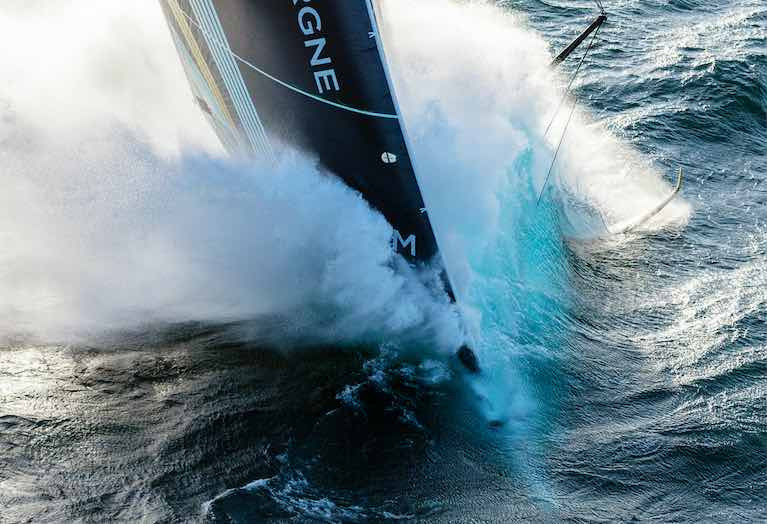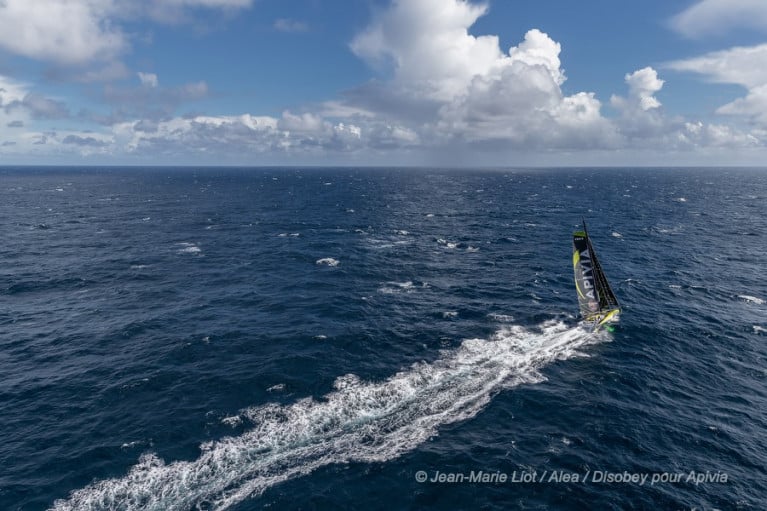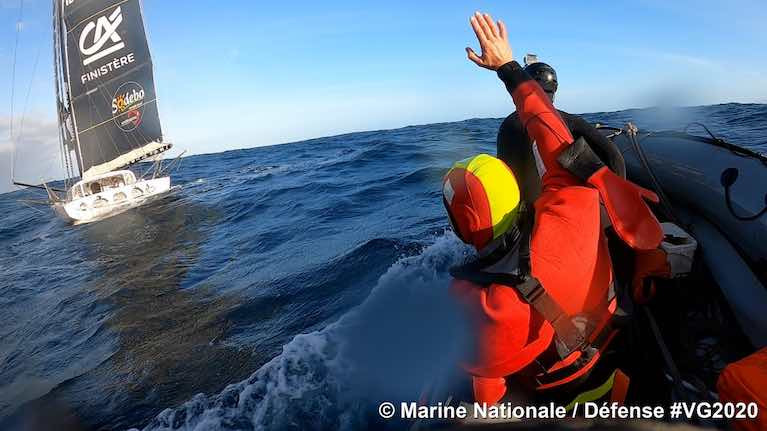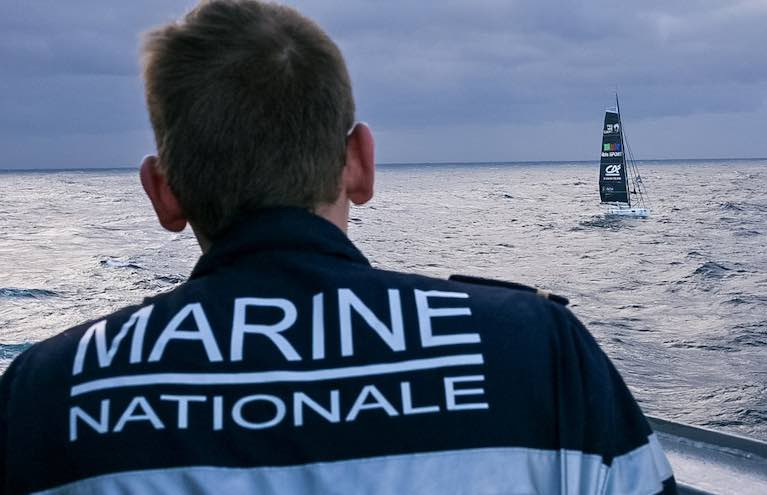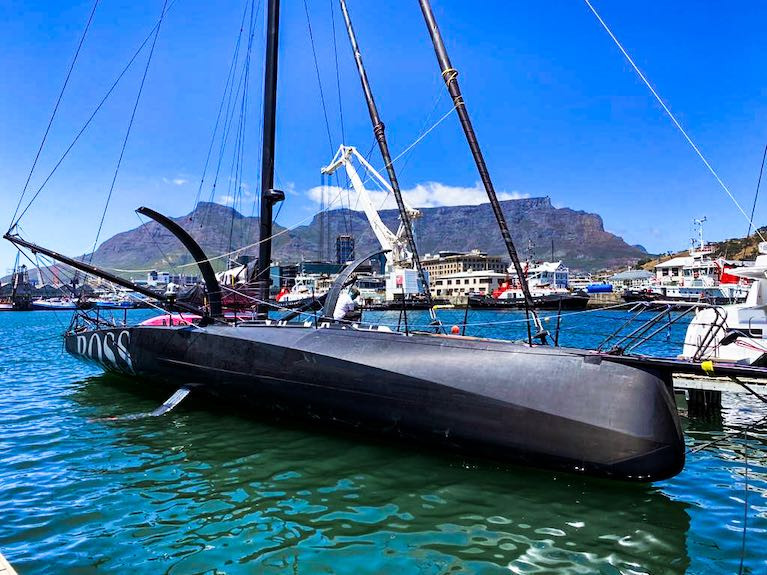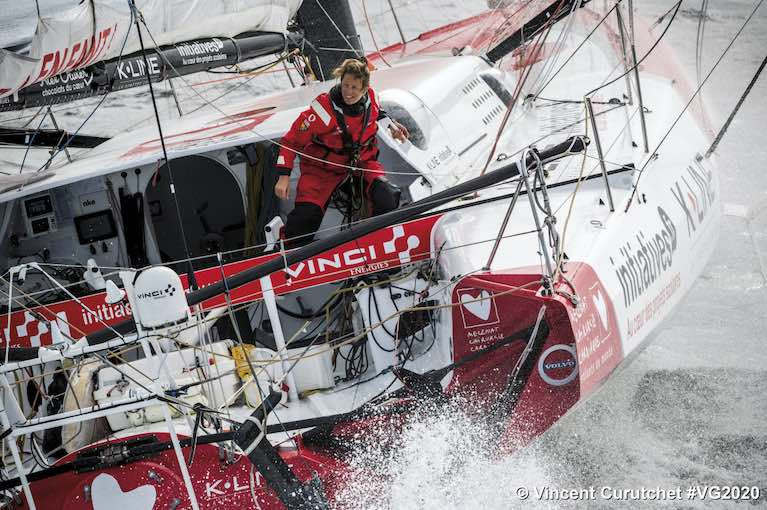Displaying items by tag: Vendee Globe
Dalin Leads Across Cape Leeuwin Then Hits 24 knots in Vendee Globe
Day 35 at Cape Leeuwin - As if to prove to that his slow speeds were indeed down to a prolonged dose of light winds and not any technical problems, Vendée Globe race leader Charlie Dalin lit the afterburners on APIVIA this afternoon and enjoyed his fastest spell of his time in the last 1000 miles of the Indian Ocean, making sustained averages of more than 24 knots.
Dalin crossed the longitude of Cape Leeuwin at 1125hrs UTC this morning, leading at the second of the solo round the world race’s three great capes as he also did at the Cape of Good Hope 12 days and 7 hours previously. Thomas Ruyant (LinkedOut) crossed Leeuwin some 3 hours and 9 minutes later with Yannick Bestaven (Maître CoQ) only nine minutes after second-placed Ruyant.
The top ten solo racers may be closer than in any previous Vendée Globe but this ninth edition is substantially slower than the 2016-17 edition. Dalin’s elapsed time from Les Sables d’Olonne is 34 days and 20hrs which is 6 days 1 hour and 53 minutes slower than Armel Le Cléac’h’s race record pace set en-route to winning the last Vendée Globe four years ago.
In fact, even with the leap in foiling technology, Dalin’s time to Cape Leeuwin today is the same elapsed time as Alex Thomson made in 2012 when he was in third position on his Farr designed former HUGO BOSS, then chasing Le Cléac’h and François Gabart.
Racing on the back of a depression under Australia, Dalin, Ruyant and Bestaven all had a spell of high speed sailing this afternoon as they try to win back miles.
Bestaven has been outstanding in the Indian Ocean, making up more than 300 miles to be virtually alongside Ruyant this afternoon.
After his first attempt ended after just over 24 hours into the Bay of Biscay in the 2008 race when his mast snapped, Bestaven 47 from La Rochelle has waited 12 years to come back to the Vendée Globe. He and Kito de Pavant – who also dismasted within the same hour - can now just about smile about theirs being the shortest Vendée Globe races in history. In their misery back in Les Sables d’Olonne they bonded and have since enjoyed a history together including racing in the colours of Bastide Otivio (formerly Initiatives Coeur and originally PRB) to fifth in the 2017 Transat Jacques Vabre. Bestaven has two Class40 victories to his name on that transatlantic race.
Almost as impressive in the Indian Ocean so far has been Isabelle Joschke lying ninth on MACSF. Her course was highlighted on today’s LIVE programme by Loick Peyron as being one making consistently high average speeds and smooth trajectories, “It is interesting to analyse the track the boats leave and they are not all the same. The foilers tend to accelerate quite suddenly and this then imposes quite sudden radical changes in the course to try and slow them. It is easier to change and modify slightly the course than it is to change the sails. So, you do see very rough tracks, Isabelle does very smooth and beautiful lines as does Jean Le Cam. It is interesting that those with the most experience of ocean racing tend to have more smooth trajectories. You do not show your talent purely by the trace you leave from your trajectory, but it is a sign. It is not the skipper who goes the fastest, that wins, it is the one who maintains the best average and consistency. It is true to win a race you have to finish it.”
Joschke responded, “Sometimes it goes fast and then it stops for a bit because you have to repair something or because the sea state is really hard to sail in and then it takes off all over again. It has been like that for a week. Quite frankly I do not know what is going to happen tomorrow and just try to manage things on a day-to-day basis. If it possible to go fast I do, but I also know that it is very wearing on myself and on my boat. I need to preserve my boat. I would say that preservation is the one word to keep in mind on this round the world race. Initially I was scared, really scared of the cold, of having problems in the cold and not having the resources to fix them. I have also found a sea that is much more uncomfortable than I had expected. I thought I would have more moments of enjoyment. I have had moments, but it has been very difficult and challenging, particularly mentally. The seas have been truly chaotic and irregular. It is quite incredible. But I have discovered some stunning landscapes and a real sense of solitude. The fact that it is hard, it makes the solitude even more pronounced and the feeling of being all alone at the end of the earth. That is something that is not easy to live with but at the same time it is just so beautiful.”
Peyron was quizzed about life in the first edition of the race on which he finished second,
“Are we scared of what we do not know or are we more scared of what we know? That is the question, and I was truly scared when I was sailing right up against the icebergs. I would count them, and it was a bit mad that we raced so far down, in the 60s, particularly Jean Van de Heede who faced a wall of white and had to head north for 24 hours to get out of it. We did sail slower. But I mean if you sailed into an iceberg at 10 / 12 knots it would still be like crashing into a cliff. It was truly scary but also one of the most incredible things ever, to have seen so many icebergs. Thankfully there are limitations now and they get changed and everything has moved continuously.”
Peyron spoke warmly of Le Cam and Seguin, racing side by side in fourth and fifth places,
“Damien Seguin and Jean Le Cam know how to perfectly compensate for any deficits they might have in terms of physically or of age. They exploit, not by going fast all the time, but by using an economy of approach and looking after their material. That’s was is so beautiful about this Vendée Globe is that there are so many different ways of expressing themselves so differently, with different boats and different sailing styles.”
The decisions of the five-strong International Jury regarding time compensations for Jean Le Cam, Yannick Bestaven and Boris Herrmann who were all involved in the rescue mission for Kevin Escoffier will be published on Wednesday.
14:00 UTC
1. Charlie Dalin - [ APIVIA ]—> 13,710.6 nm from the finish
2. Thomas Ruyant - [ LinkedOut ] —> 57.77 nm from the leader
3. Yannick Bestaven [Maître CoQ IV]—> 71.17 nm from the leader
4. Damien Seguin [ Groupe Apicil ]—> 266.54 nm from the leader
5. Jean Le Cam [ Yes We Cam! ] —> 268.09 nm from the leader
Vendee Globe Leader Dalin is Under Pressure, Less Than 100 Miles Separates Top Three Skippers
Day 34 - With less than 200 nautical miles to make to cross the longitude of the Cape Leeuwin, Charlie Dalin’s lead on the Vendée Globe fleet is a much more tenable 81 nautical miles after long periods slowed in light winds during the last three days of racing.
Quizzed early this morning he denied he has any technical issues on board his IMOCA APIVIA:
“I know there is speculation about me having technical issues but my only technical issue has been no wind. APIVIA is going well,” he asserted!
The leader’s elapsed time to Cape Leeuwin should be of the order of 34 ½ days, nearly six days outside of the outstanding record set on the last edition by Armel Le Cléac’h at 28 days 20 hours and 12 minutes. Le Cléac’h’s passage time back in December 2016 beat the previous record by 5 days and 14 hours.
But while the last two editions of the Vendée Globe had already been distilled down to head-to-head match races, this ninth edition is a much more open affair.
In 2012-2013 at Cape Leeuwin there were five hours and 49 minutes between the runaway duo Le Cléac’h and Francois Gabart. Alex Thomson was over one day and three hours behind.
And in December 2016 there were five hours and 16 minutes between Le Cléac’h and Thomson.
Today there are less than 100 nautical miles between leader Dalin, second-placed Thomas Ruyant (LinkedOut) and third-placed Yannick Bestaven (Maître Coq IV). Jean Le Cam (Yes We Cam!) is 130 miles behind Bestaven and he, in turn, has three skippers, Damien Seguin, Louis Burton and Benjamin Dutreux, all within 40 miles.
And at current speeds there is less than a day or just over 400 miles between first and 10th.
Burton Has Issues
Louis Burton, who a matter of a week ago was in second, 140 miles behind leader Dalin, admitted today that his problems are more than just the autopilot issues which he detailed a few days ago. The skipper of Bureau Vallée 2 has dropped to sixth, now 246 miles behind leader APIVIA. He revealed that he has damage to his mainsail lock (hook) and to the upper part of his mast track to the point that the maximum hoist he can use the mainsail to is with one reef.
He explained, “I still have the J2 which is working fine, but the small gennaker is in bad shape so I don't have a lot of headsails. I also have energy problems which are holding me back quite a bit. I’ve got a hydro generator stuck down which actually slows it down a lot, but I don't have much choice since I don't have enough fuel to finish the rest of the race using my engine (to generate power). That's an extra worry. The problem with my pilot is fixed, and I’ve tried to make sure all those little fragile sensors are now watertight so that the problem doesn’t come back.”
Burton spoke of his 2016-17 race on which he finished seventh:
“Compared to the last Vendée Globe, there is less wind, and the sea is calmer. But in saying that up until this point, the conditions have really been boat-breaking. Four years ago, when we passed through this zone, there were really high seas and the wind was much stronger, but there’d been more extensive weather systems, so fewer manoeuvres to make and therefore less danger for the boats. This time round, it’s really not been easy to manage. We're now going to enter a zone that will be less wind between the Indian Ocean and the Pacific. It's not the Big South as I like to imagine with the usual big depressions on which you can stay a long time. Instead, the conditions are very changeable and very trying, which also explains why the boats are coming back from behind. "
Good For Hope, Good For Morale
The Finnish airline pilot Ari Huusela was the final Vendée Globe competitor to cross the longitude of the Cape of Good Hope today, 33 days and 22 hours after the start off Les Sables d’Olonne on Sunday 8th November. That he was some ten hours and eight minutes behind Sébastien Destremau mattered not at all to the 58-year-old from Helsinki.
Indeed, he may be the 29th racer to cross but it is doubtful if any of the 29 ahead of him have been happier to cross this first of the course’s three Great Capes. He is on the threshold to the Indian Ocean on STARK, his Owen Clarke designed IMOCA which already has two racing circumnavigations under its keel, and that represents a big leap into the unknown for Huusela who has been planning his Vendée Globe for the best part of twenty years, and is in no hurry to have it finish any quicker than he would like it to.
“It feels so good to be passing this first Great Cape. It feels so good. It has been a lot of years coming since we started this project and so it feels really good. I am relieved. Next is Cape Leeuwin in two to three weeks. I am so, so happy today,” smiled Huusela, one of the three skippers in this race who might strictly be described as amateurs, that is to say deriving their primary income from outside of sailing, along with Didac Costa who is a full-time fire officer and Manuel Cousin who had a career in the automotive industry with Toyota.
Crossing Good Hope just ten and a half hours earlier than Huusela was Jérémie Beyou. The skipper of Charal who restarted again nine days after the original start was pleased to reach one of the little targets he had set himself, to be catching up with the back of the fleet by the Cape of Good Hope.
Beyou, whose passage to the Cape has not been easy as neither the North Atlantic nor the South Atlantic have been kind to him. His elapsed time is 24 days 9 hours and 14 minutes, 15th fastest of the fleet.
“It is not so much about passing competitors now which finally feels good but more just to have got back in touch with the race, to have made up the miles I was behind (1250 leaving from Les Sables d'Olonne on November 17), but at least now I am in the same weather system as others and I have people around me as I head into the Big South. I wanted to be here, catching the race by Good Hope and so I have done that and I'm happy. "
Vendee Globe Leader Dalin Sees Lead Halved in Last 36 Hours
Leader Charlie Dalin has seen his Vendee Globe Race margin more than halved in the last 36 hours as he negotiates a high-pressure zone of lighter airs some 630 nautical miles west of the longitude of Australia’s Cape Leeuwin.
The race favourite before the start, Charal, which restarted days later after repairs as allowed under the rules, has picked off the last backmarker and is set to overtake 4 or 5 others in the next day or two.
The perils of being first to break into gentler winds are obvious as he sees the chasing duo have closed up to within 100-120 nautical miles of him, albeit partly as he repositioned himself further to the south. But while some have been questioning if Dalin is hiding damage which might account for his slower speeds the 35-year-old who originates from Le Havre has been sailing into the lightest wind of any of the top 15 boats.
“Charlie is facing an area of lighter winds for a few hours, those chasing after him are sailing in 15-25 knot SW’ly winds, offering them high speeds and allowing them to narrow the gap. The first fourteen boats from Apivia to L’Occitane en Provence (Armel Tripon) are today sailing in the same weather system with the Mascarene High stretching out across the whole of the Indian Ocean.” Noted weather supplier Christian Dumard this morning at his briefing to Vendée Globe HQ.
Vendée Globe veteran Jean Pierre Dick said today on the French Vendée Globe Live, “The leaders do tend to keep quiet about any issues they might have, to not give away anything to those chasing that might give them a chance to use it against them. That has often been the strategy of past leaders such as François Gabart, Armel Le Cléach or Michel Desjoyeux. I think that Charlie Dalin is in this area of light winds.”
Of life in the barren South Jean Pierre recalls, “I have spent nearly 6 months in the Southern Ocean over the course of the racing I have done and what impresses me the most is the sense of vastness and desolation. Over the course of the six months there, I never once saw a boat. The only one was PRB in 2008 when we nearly hit each other. It is so vast, savage and then seeing the albatross is a true honour to be there.”
“Then there is a form of optimism when you know about the climate change, the earth warming up and the pollution, being down there at one in nature and not seeing a living being for that long, you feel that you are in the one part of the world that you breathe, and that the world somehow heals itself from our urban excesses. What strikes me the most when I see the images sent back is the human isolation and the sporting battle one has with oneself. How to stay zen in the face of all the problems you have. It is not always to ensure to have less sail than you might like, as a competitor, but you have to also look ahead when winds change so suddenly from 15 to say 30.” Dick observes.
Dalin continues to play the long game in an assured fashion. He is without doubt measuring the threat from those behind him in the knowledge that his boat, assuming it to be at 100 per cent or close to it, should be the fastest of those in the top 11.
“He will be looking at the threat from behind and knowing that he should be able to be fastest. I think he is very much controlling the fleet knowing he can match them if he is at his best.” Notes four times Vendée Globe racer Mike Golding this afternoon, “That said we are still not seeing the averages we should have been seeing from these foiling boats and I wonder whether everyone is being generally quite cautious. For Charlie his biggest worry would maybe be in the South Atlantic climbing north again and that threat might come from Yannick Bestaven who is going well and Louis Burton who continues to impress me. But that is a long way off. There are some very good sailors in this group. But in terms of speeds so often it is down to the wave patterns. In the 2012 race in the Indian Ocean it was like this, there was never just the time to get the boat really rumbling for long periods.”
It has been a key moment of the race so far for Japanese skipper Kojiro Shiraishi who crossed the longitude of Cape of Good Hope at 1053hrs this morning on DMG MORI. After having to retire into Cape Town with a broken topmast in 2016, Shiraishi was has passed his stopping point and was going well today, crossing just four hours and 24 minutes after Briton Miranda Merron (Campagne de France) who passed just 37 minutes after Alexia Barrier (TSE 4 My Planet).
Suffering from a breakdown of his backup computer – his first, main computer failed off Cape Finisterre – Fabrice Amedeo confirmed he will abandon his Vendée Globe in Cape Town. This afternoon he had just over 130 miles to sail to the South African haven. Journalist turned round the world racer Amedeo finished 11th on the 2016-17 race but had to restart two days after the start due to a hairline crack at the top of his mast.
Recovery Time for Vendee Globe Leaders Dalin, Ruyant
Day 32, less than 1000 miles to Cape Leeuwin: The Vendée Globe’s leading duo Charlie Dalin and Thomas Ruyant are into a period of quieter winds as they recover from the big Indian Ocean storm which hit them on Tuesday night with gusts to 55 knots of wind and big seas.
Southern Ocean first-timer Dalin, 35, admitted this morning that he felt he and his boat had been very close to their limits and that at times he has turned down the wind fields on his navigation systems as the sea of red on the screen was only making him more anxious.
But the rewards for their caution, care and seamanship seems to be a relatively straightforward passage to Cape Leeuwin where Dalin expects to pass between Sunday night and Monday.
“I feel like I have earned my Southern Ocean spurs” chuckled Dalin who had never raced south of Itajai, Brazil before this race.
The leading pair on their Verdier designed IMOCAs are 214 nautical miles apart this Thursday afternoon, both making less than 12 knots in lighter airs with less than 1000 miles to make to the race’s second Great Cape.
Holding third this afternoon is Yannick Bestaven on Maître CoQ whose speed, composure and smooth strategies are proving a match for Louis Burton who is ten miles behind. Remember that Bestaven, Boris Herrmann (SeaExplorer-Yacht Club de Monaco) and Jean Le Cam (Yes We Cam!) have yet to be allocated their time allocation – redress – for the time and distance lost by them during and subsequent to their efforts to rescue Kevin Escoffier.
At 47 years old, Yannick Bestaven has 20 years of ocean racing experience under his belt. He served his apprenticeship with the legendary French technical innovator and Vendée Globe racer Yves Parlier, winning the IMOCA class’s Tour of Europe series in 1999 with Ellen MacArthur and Parlier on his Aquitaine Innovations before self-building a Mini 650 in 2001 and convincingly winning the 2001 MiniTransat. In terms of sustainable power sources Bestaven was a long way ahead of others’ thinking when he started the 2008-9 Vendée Globe on a boat which used only renewable energy sources but unfortunately, he dismasted on the fourth day of racing in a big Biscay storm.
Since then he has built the Watt & Sea hydrogenerator business, the water-powered charging systems currently are used on 99 per cent of the Vendée Globe boats.
Bestaven’s VPLP-Verdier boat, built as Safran in 2014 for Morgan Lagravière, did not make it this far on the 2016-17 race, retiring into Cape Town with steering problems. The poultry foodstuffs sponsors took on the boat early after the last race and picked Bestaven as their skipper.
As they reach a spell of more settled weather now, and particularly in a couple of weeks time in the longer, rolling swells of the Pacific it will be interesting to see actually how much the fast new gen foilers are pushed.
When there was talk before the start of 500 plus mile days and the probability that Alex Thomson’s 2016 24 hours record of 536 nautical miles would fall, to date only four skippers have broken the 500 miles 24 hours day and all of them – Ruyant (515.3nms) Sébastien Simon (508.9) Charlie Dalin (505.5) and Alex Thomson (501.8) – were all over the 20-21st November.
Luck has never favoured Swiss skipper Bernard Stamm’s efforts to complete the Vendée Globe. He started four times and has never been credited with a finish time.
He completed his circumnavigation in 2012-13 but was judged to have received outside assistance whilst stopped for technical repairs in the Auckland Islands and he was disqualified. With his anchor dragging he chose in the emergency situation to moor alongside a Russian scientific survey ship but one of the crew – without being asked – helped in the manoeuvre.
Stamm paid tribute today to 46 years old English skipper Pip Hare, and to his compatriot Alan Roura for their efforts racing the IMOCA Superbigou that he built on a tight, hand to mouth budget for the 2000 race. Sadly, he had to retire early in the 2000 edition.
Stamm recalled today, “The boat was not built as I expected. I was hoping to borrow some money to make the moulds and then find a sponsor showing them the moulds rather than a detailed programme. I was forced to borrow all the money needed to build the whole boat. Lots of friends and the people of Lesconil and holiday-makers who were there came and helped me build this boat. The boat was finally finished a few months before the start of the 2000 Vendée Globe. I spent a lot on the basic structure and that was well built. I didn’t have time to work on parts like the mast. So the mast came from Isabelle Autissier, the winch from Laurent Bourgnon, the clutches from Alain Gautier so that’s how the boat was able to set off in the 2000 Vendée Globe. It was a fantastic human endeavour. I don’t know how many miles she has clocked up, but this is the boat’s fifth time around the world. I’d say 300-400,000 miles. I’m proud to see her and to see what Pip is doing and what Alain did. They have managed to do something I didn’t and that is take the boat around the world."
One month ago today, Sunday November 8th, 33 solo racers, 27 men and 6 women, took the start of the ninth Vendée Globe amidst an unprecedented health crisis. Today December 8th presents the ideal opportunity to take stock.
After 30 days of racing a press conference was held this afternoon in the Vendée Globe village, in the presence of Yves Auvinet who is President of the Vendée Globe and the Vendée Department, Lionel Pariset, who is the elected Vendée Globe delegate for the town of Les Sables d'Olonne and Jacques Caraës, the Race Director.
“For the first time in its history, the organization of the Vendée Globe had to face the challenge of a global health crisis. This unprecedented context forced all those involved in the event - organizers, sailors, teams, the public - to adapt so that the start would be given for the 33 competitors ready take on the round-the-world solo, non-stop, without assistance race. Despite these difficulties, the challenge has been met. After a month of racing the review is really excellent”, declared Yves Auvinet.
Today, almost one in two French people (49%) intend to follow the race according to the latest ODOXA - RTL - WINAMAX Barometer: it is better than the Tour de France cycling or Roland Garros!
Start Day, Sunday 8th November
The Start Live broadcast was carried on 41 TV channels (vs. 33 in 2016) and broadcast live in 190 countries (vs. 177 in 2016).
In France the live broadcast was transmitted by 13 broadcasters (vs 10 in 2016) with more than 4.1 million viewers in total watching the start (23% of cumulative audience share), notably on L'Equipe TV, France 3, BFM, and LCI.
Internationally, the race made a big breakthrough with 28 broadcasters (vs. 21 in 2016), notably in Great Britain, Switzerland, Spain, Germany and Japan.
Media coverage has grown significantly: With 192 million contacts generated, the media coverage of the start of the Vendée Globe is equivalent to a purchase of space representing 13.9 million euros with 16,239 articles published.
Digital media was also heavily used at the start with 1.39 million sessions and 5.48 million page views on the website. What is even more striking is that after 1 month of racing numbers are not dropping.
After 1 month of racing: interest in the Vendée Globe continues to grow!
The website, the app (application), social networks and digital platforms are generating much higher traffic than in 2016.
Website traffic:
31.2 million sessions for 1 month (vs 27.8 million for the 1st month in 2016)
170 million page views over the past month (vs. 122 million in 2016 over the 1st month)
Apps:
250K active users at the start and 445K after one month of racing (vs 441k users overall in the 2016 edition)
Digital platforms:
Over the month, 46.5 million cumulative views on Dailymotion, YouTube, Facebook.
After 1 month, the 2020 edition already has over 400,000 more fans than the 2016 edition!
Facebook: 379,426 subscribers (vs. 264,000 in 2016): + 44%
Twitter: 90,500 followers (vs. 54,000 in 2016): + 68%
English Twitter: 10,400 followers (created pre-start 2020)
LinkedIn: 9,520 subscribers (created in 2020)
Instagram: 168,000 subscribers (vs. 23,800 in 2016): + 606%
YouTube: 94,100 subscribers (vs. 12,000 in 2016): + 684%
The Vendée Live show broadcast on Infosport+ has clearly been successful on digital media (Facebook, Dailymotion and YouTube) with on average three times as many viewers as in 2016 (45,000 on average in 2016 / 130,000 on average in 2020).
Newsletter: 200,000 subscribers, or three times as many as in 2016 (66,000 in 2016).
The general public present in spite of lockdown rules and the health crisis
The free e-ticketing system enabled the Vendée Globe to reconcile the health and safety rules with the enthusiasm of the visitors. Between 17th October and 29th October, within the limits set by the health authorities, the village saw 15,000 visitors a day, remembering that only 5000 people were allowed at one time in the Village. In all, 200,000 people visited the Village.
As for the origin of the visitors, 2/3 of them came from the Pays de la Loire Region, with just over 40% of them from Vendée, with 1/3 from the rest of France and 1% from abroad.
Virtual Regatta, a huge success
The success of the virtual race confirms the penetration of the Vendée Globe into homes in France and abroad. 975,000 gamers registered, which is twice as many as four years ago (456,712 gamers in 2016).
The virtual race attracts people from outside of France with almost 20% in foreign countries representing 150 different nationalities, with in particular, people from the United States, Switzerland, the UK and Spain.
Finally, it has been an unprecedented success amongst schoolchildren: 4354 classes are taking part in the Virtual Regatta Academy rankings, which is almost three times as many as in 2016 (1600 classes in 2016).
The Vendée Globe, a genuine educational method for children and teenagers
Developed by the Vendée Department, Vendée Globe Junior offering new fun and educational tools, has been a resounding success. 6000 educational packs have been distributed with an updated website which has new features and this too has been increasingly popular: 2.8 million pages viewed, which is an increase of 373 % in comparison to 2016; 220,000 visitors, or on average 6000 visitors a day.
The race itself: Jacques Caraës, the Race Director, carries out a full appraisal
The composition of the fleet
In comparison to previous editions, and in particular 2016, the racers, in spite of COVID restrictions, have sailed more, and certainly more than four years ago. The selection process that was put in place (number of races and number of miles to cover to qualify) required the competitors to take part in races: The Monaco Globe Series, the Route du Rhum, the Bermudes 1000 Race, the Rolex Fastnet, the Transat Jacques Vabre and the Vendée Arctique les Sables d’Olonne. The boats have been well-prepared, even in the smaller teams. There has been a higher standard of preparation. There are also some highly innovative boats, which had not been tested in every set of conditions, such as in heavy seas sailing downwind. This means we will be able to carry out a thorough appraisal at the end of the race. For the new foilers, the Vendée Globe and the Southern Ocean have been a testing ground. In heavy weather, and in cross seas, the well-prepared traditional boats have managed to keep up a pace close to the foilers, as they are unable to use their foils all the time.
In the South, the chosen trajectory is also very important. The more experienced sailors, even in older boats, have managed to keep up the pace in the group of the 5-10 leading the race. In the end, it appears that the ability of the boats seems to be closer together than expected.
The weather
So far, the weather has not been easy. In the Southern Ocean, there have been some very active systems. The lows tend to deepen and move very rapidly. This has generated very untidy seas with huge waves. This has been a particularly difficult Vendée Globe. In the Northern Hemisphere they did not find the fast sailing they expected in the trade winds. Only the passage through the Doldrums was quicker than usual.
Retirements
Out of the 33 at the start, five boats have been forced out with damage. This is a proportion that is not that surprising unfortunately. We need to remember that the average proportion of boats retiring from the Vendée Globe is around 50%. For the moment, this has chiefly concerned the newer boats.
The gaps and race times
The gaps will perhaps be wider than in previous editions. The leaders are only in the middle of the Indian Ocean. When they enter the Pacific, the gaps will widen, which is hardly surprising. If we compare the oldest boats with the latest generation ones, the differences in speeds are huge, with some achieving almost double the speed of others.
Race times
It is always tricky to talk about a record in the Vendée Globe, as in a race like this one, you do not get to choose your weather opportunities and this means conditions have a major influence on performance. The boats can clearly perform better, but they may not improve on the reference time of 74 days (set by Armel Le Cléac’h, the winner of the last edition). It is still too early to make any predictions.
The Vendee Globe Battle Between Dalin & Ruyant Continues at the Front of the Fleet
One of the outstanding performances of this Vendee Globe so far has been by Louis Burton on Bureau Vallee II who, despite recent auto-pilot problems, is continuing to hold his own in the top-three on the boat that won the last race.
Up ahead of him, the fascinating battle between Thomas Ruyant on Linked Out in second place and Charlie Dalin, one better than him on Apivia, continues, night and day.
Dalin has been leading for 13 days and right now he and Ruyant are contending with wildly gusting winds and confused seas, about 750 miles northwest of the Kerguelen Islands - one of the windiest places on earth.
Of course Ruyant is handicapped by having lost his port foil. But the interesting aspect of the last few days is how steady the gap has been, given this shortcoming for the LinkedOut skipper and the fact that he has mainly been on starboard tack.
 Thomas Ruyant is sailing without his port hand foil
Thomas Ruyant is sailing without his port hand foil
His team management say the key here is that Dalin himself has been having to slow his boat to cope with the sea and wind conditions, allowing Ruyant to stay in touch. The question is how long that can continue and whether Ruyant can remain in contention once the boats start climbing north again in the south Atlantic.
A few days ago Guillaume Verdier, who designed both boats, remarked that while Apivia is an all-rounder, Linked Out has been slightly more optimised for upwind speed and reaching with the Ocean Race in mind.
Marcus Hutchinson, the team manager for LinkedOut says, in reality, the differences are so small they are hard to factor into performance. "The boats are very, very close sisterships," he said. "The most significant differences are only of pencil-thin thickness."
 Ireland's Marcus Hutchinson is Thomas Ruyant's team manager
Ireland's Marcus Hutchinson is Thomas Ruyant's team manager
Hutchinson says Ruyant is effectively sailing on two boats - an IMOCA 60 with a split personality. On one tack it flies, on the other it doesn't, while Dalin - whose foil package is his older V1 set-up - is racing a balanced boat.
"When they change gybes, probably this morning, Thomas will have to learn again how to sail his boat as a foiler," explained Hutchinson, "and without taking too many risks.
Conservative Vendee Globe Leader, Dalin Plays Prudent Long Game
After being rescued from his liferaft six days ago by fellow Vendee Globe competitor Jean Le Cam, PRB skipper Kevin Escoffier was plucked from the Indian Ocean by the French Marine National after jumping clear of his rescuer’s IMOCA 60 in a carefully choreographed manoeuvre early this Sunday morning some 360 nautical miles north of the remote Crozet Islands. Escoffier was quickly taken from a semi-rigid inflatable to board the 93.5 metres long (306ft) 2600 tonne Floréal-class frigate which has a complement of 84 crew.
The mission was accomplished swiftly and without setback around daybreak at 0210hrs this morning (Crozet is +4hrs UTC) Le Cam wished his passenger Escoffier well and continued on his race, lying in sixth position at 396 miles behind leader Charlie Dalin (Apivia) and 15 miles behind fifth-placed Ben Dutreux (OMIA-Water Family).
For his time and miles lost while out of full race mode, Le Cam will be granted a time compensation by the International Jury, as also will Boris Herrmann (Seaexplorer-Yacht Club de Monaco) and Yannick Bestaven (Maître Coq) who went to help in the search for Escoffier after his IMOCA suddenly split virtually into two when it buried its nose in a big wave.
Meantime Le Cam’s request for additional food to replace that required to feed shipwrecked Escoffier was granted and the 61-year-old Le Cam who enjoys fine food took a bag containing dry crisprolls, salted butter and fine Henaff Breton pate. Escoffier will be taken back to Reunion Island where the Nivôse is stationed and is due to arrive there next Friday.
Le Cam chuckled “I’m alone again. After two of us being aboard, alone again. Clack-clack-clack. There they go!"
“Kevin is in great shape, he is going to enjoy a hot shower," said Frédéric Barbe, captain of the Nivôse. “And so a great start to a beautiful day!"
At the top of the 29 boat fleet, Charlie Dalin, Thomas Ruyant and Louis Burton all gybed on to the new north-westerly breeze which heralded the arrival of the new, active low-pressure system. Burton had dropped a few miles to Ruyant and Dalin because of autopilot and other unspecified issues but he said today that the seas have evened out after a week of crossed, agitated waves. His autopilot issues had required him to helm his Bureau Vallée for long periods before finally effecting a fix in collaboration with his technical team.
Burton Burnt Out? Not really…..
“I'm pretty burnt out and I admit that I came close to having to abandon". Reported Burton this morning, now recovered to be back up to second, 13 miles ahead of Thomas Ruyant.
“Now the strategy is to try and stay ahead of the front. We are on it early. I have lost a bit of ground so I am not sure where I am but the idea is to go fast and as far as possible on this port gybe and either I manage to stay ahead of this front, which is going to be very strong and which would be good, or it go over us in about two days and then it will be a starboard gybe to just carry on the course. I have not seen the files from midnight, but those are 1800hrs show a transition that did not look great around the Kerguelen Islands. It could be pretty amazing if we can do it all on one tack ahead of the front, but there are going to be quite lot of manoeuvres. What I have to absolutely do is tidy the boat before I get some sleep. Having a mess just leads to more problems, accidents. I am then going to just go as fast as possible. I tell myself that the others must also have issues to deal with and you just have to hang in there.”
Options
Their dilemma, indeed that of all the lead group is a front which arrives next Tuesday, dark red spot on the weather maps yielding 45-50 knots and 7.5 meters wave troughs. Tomorrow they will have to make a choice.
"Either they go through the front and find themselves in the heart of the storm, or they slow down and the front will go faster than them", explains Sébastien Josse, Vendée Globe weather consultant.
Leader Charlie Dalin seems to be taking the more conservative option, as might be expected of a skipper with a 200 mile lead and a boat believed to be still close to 100 per cent of its potential as the fastest, newest most proven foiling boat which has already won last year’s Transat Jacques Vabre. He appeared to already have slowed down today Sunday.
Of this leading group of 11 skippers, all are wondering what to do. "I planned to tack around a bit," said Benjamin Dutreux (OMIA - Water Family), still impressive and keeping up with the race pace.
Some 450 miles further back to the west, smiles are back on the faces of Romain Attanasio and Clarisse Crémer. The 12th and 13th placed skippers – 16 miles apart - are finally finding stronger winds after light airs slowed them (over 15 knots since this morning) and they have had fun chatting on WhatsApp.
Attanasio skipper of PURE-Best Western Hotels & Resorts remarked: “I have really picked up speed. The boat is hitting the waves, there's a hell of a racket and what is good now is that this going to last for five days. When you miss a system and a bit surfing session during a transatlantic race you blame yourself but here on the Vendée Globe you're actually happy as it gives you a bit of a break! "
Respite isn't really on the menu some 600 miles further west. Alan Roura (La Fabrique), Stéphane Le Diraison (Time for Oceans), Armel Tripon (L’Occitane en Provence) and Arnaud Boissières (La Mie Câline - Artisans Artipôle) cross Cape of Good Hope today in succession after a spell of very light winds. They are seeing a very tough depression descending on them from South Africa from late today. "They will be stuck in front of the AEZ and have to go upwind as long as it does move further south," notes Vendée Globe meteorologist Christian Dumard.
"It is not looking like fun at all it really will not be really easy to manage," confirmed Alan Roura, guest of Vendée Live this afternoon.
At around 0210hrs UTC at a location in the South Indian Ocean some 360 miles north of the remote Crozet archipelago, Kevin Escoffier (PRB) was successfully transferred from Jean Le Cam's IMOCA to the Nivôse, a French Navy frigate.
Escoffier was dramatically rescued last Monday by fellow Vendée Globe competitor Jean Le Cam after his IMOCA PRB broke in two when it nosedived into a big wave. The 35-year-old skipper from Saint-Malo had spent 11 and a half hours drifting in a liferaft before being picked up by 61-year-old five times Vendée Globe veteran Le Cam.
The evacuation of Escoffier - via a Nivôse rigid inflatable boat - went well, despite the big seas in the area.
 Kevin Escoffier (PRB) (right) was successfully transferred from Jean Le Cam's IMOCA to the Nivôse, a French Navy frigate
Kevin Escoffier (PRB) (right) was successfully transferred from Jean Le Cam's IMOCA to the Nivôse, a French Navy frigate
And so Jean Le Cam has resumed his race in solo mode. In a message to the Vendée Globe Race Direction, Frédéric Barbe the captain of the Nivôse, wrote: “Kevin is in great shape, he is going to enjoy a hot shower. We are heading for Reunion Island. It is the start of a beautiful day."
Nivôse is a Floréal-class frigate which has 84 sailors on board and its main missions are the surveillance of maritime areas under French sovereignty in the Indian Ocean (Reunion, Mayotte, the French Southern and Antarctic Territories) and the fight against illicit activities at sea. It is based in Port-des-Galets, on the west coast of Réunion island, Nivôse is 93.5 meters long, 14 meters wide and has a displacement of 2,600 tonnes.
Alex Thomson Arrives in Cape Town & Formally Retires From Vendee Globe
Each edition of the Vendée Globe, Cape Town, South Africa provides final safe haven for stricken solo racers to retire to, restore their mental equilibrium, to reflect on what should have been and to enjoy the safety and security of terra firma after nursing an injured IMOCA to port.
After nearly seven days and 1,800 miles since he announced his hopes of winning the 2020 Vendée Globe had been terminated by a broken starboard rudder, Alex Thomson arrived in Cape Town this morning. He will be joined over the weekend by the young Vendéen skipper, Sébastien Simon, who also announced he has had to give up the race because of damage to his starboard foil casing and his foil on the Juan K designed ARKEA PAPREC.
Of the 33 IMOCAs which started the race, four have now officially abandoned, CORUM L’Épargne, PRB, HUGO BOSS and ARKEA PAPREC.
Thomson said, “I’m still coming to terms with what’s happened, and I’m obviously utterly devastated that this is how the race has ended for us.”
“But, as I’ve said before, it’s in our toughest moments that we find our greatest strength. Now we have to pick ourselves up and move forwards, and I’ve no doubt that we can do that together as a team. Over the past week or so we’ve been reminded of just how difficult this race is. I’ve said it time and time again but there really is no sporting challenge in the world as tough as the Vendée Globe. I have such admiration for any skipper who takes on this race. My thoughts go out to those who, like us, have had their races cut short. And I wish the remaining skippers a safe passage and a good race. I’ll be watching closely.”
The British skipper has been forced into Cape Town in early December before. His first Vendée Globe ended with his retiral on 7th December 2004 after an area of his coachroof around the mast gave way due to a structural problem. And in 2006 he and Mike Golding arrived in Cape Town on December 3rd 2006 after Golding had dramatically rescued Thomson from his IMOCA in the Southern Ocean after he had to abandon it because his keel had failed. Golding’s mast broke not long after the rescue and the pair had to sail 1000 miles north under jury rig.
Britain’s Sam Davies is making steady progress north under reduced sail nursing her damaged Initiatives Coeur back to sheltered waters and this afternoon was about 80 miles south of Cape Town. After the best sleep since she hit a floating object which has damaged the structure round her keel, Davies admitted that the emotions were suddenly released as she was accompanied on her route by an albatross, “The sun came out too which helps to ease the aches and pains - I went and sat outside in the warm sun. And then suddenly found myself in floods of tears - and this is a bit weird for me, who never cries, to deal with all these emotions. I wasn’t even sure why I was crying - whether it was sadness for my boat and for my place in this race, or relief that my boat and I are safe? Or a mix of all these emotions? I’ve always felt that it’s stupid to cry when you are alone on your boat - nobody’s going to help you or hug you or reassure you so it’s pretty much a waste of time and energy. But at that particular moment I had no control over these emotions. I leant on the coach roof and looked out and there, right there, really close, unusually close, was the most beautiful albatross I have seen, gliding past silently and slowly. He was so close. Normally the albatrosses keep their distance but this was different, as if he could feel my emotion and wanted to help. He stayed close and gave me a wonderful display of effortless flight that was a welcome distraction. They say that albatrosses have the souls of sailors of the past and I can well believe that. I feel like I am being escorted to safety by these amazing creatures and I am grateful for their concern!”
Meantime, yesterday night, Romain Attanasio (Pure-Best Western), Davies’ partner was nervously crossing the exact same zone where she had her collision two days ago and where four years ago he hit something which damaged his rudder, requiring him to repair at anchor off Port Elizabeth.
“I am fully in the zone where Sam and Seb hit their OFNIs and it is exactly the same area as I did four years ago, the same spot same latitude, same longitude it is in the Agulhas current, there are all sorts of things in the water, objects, it is a zone which is a bit critical. I am reaching in quite a big sea and so I am on high alert. I have my eyes on OSCAR as much as possible, this camera system that surveys the route. You can’t see much in the water on the surface. So, it is not easy all this.” said Attanasio.
Conditions are still demanding for the fleet leaders who will shortly be able to angle more to the south east after passing the corner of the Antarctic Exclusion Zone. Led by Charlie Dalin (Apivia) with Louis Burton now just 140 miles behind on Bureau Vallée, they are still all struggling to set a good average speed in the typically big seas and gusty winds. A second, deeper low pressure is set to combine next week to provide very testing conditions which it is most likely the leaders will change their route to avoid.
The top ten now contains a fascinating mix of solo racers, six of them racing in the ‘big south’ for the first time, Charlie Dalin, Yannick Bestaven, Damien Seguin, Benjamin Dutreux. Isabelle Joschke and Giancarlo Pedote and still three non-foiling boats, those of Seguin, Dutreux and Jean Le Cam.
Louis Burton’s attacking force seems relentless, his wife Servane noting today on the Vendée Live English programme, “Louis never stops surprising me, but he has a mind of steel. When he went south he asked me, ‘will you still love me if I screw up?’
After both hitting floating objects within hours of each other yesterday at the gateway to the Indian Ocean and sustaining damage to their IMOCAs the emotion in the voices of both Sébastien Simon and Sam Davies was a stark reminder of the cruel fates which are randomly dealt to even the best prepared and smartest Vendée Globe skippers.
Both are heading north towards South Africa out of the worst of the strong winds and big seas, sailing slowly north to shelter and assess their possibilities of repair. “I want to be able to continue my Vendée Globe”, said Simon, the 30-year-old from Les Sables d’Olonne who won La Solitaire du Figaro in 2018, close to tears. He has constant water ingress from around his foil box, while Davies damaged the longitudinal framing which supports the keel of Initiatives Coeur.
I hit something
She reported: “I was sailing at speeds between 15 and 22kts and I was actually just making a hot meal after the gybe and doing the stack and everything and it was just starting to get dark. I hit something. I did not see anything. I did not know what it was. It was pretty much dark when it happened. But it was as if I had run aground on a rock at the time. The boat speed went from 20kts to zero. The boat nosedived on the impact with the keel. I knew it was the keel. I heard a crack coming from there. I and everything else flew forwards, including my dinner which has repainted the entire inside of my boat. Everything moved. I went flying into a ring frame, luckily, because that could have been worse. It was really violent. But luckily, I have just hurt some ribs. It is not serious but really painful. But I stopped the boat, dropped the main, and went to check around the keel, the bearings and the bulkhead. The bulkhead, the main bearing bulkheads (which support the keel box) are intact as far as I can see. The keel bearings are intact. The longitudinal structure around the keel box is all cracked. That has taken the shock of the impact of when the boat moved, that is cracked on both sides.”
Vendée Globe Race Director a renowned former ocean racer Jacques Caraës empathised with the duo today. He explains: “Usually when you get to the gateway to the Indian Ocean, you go into another world, in another mode. You are reserved and back off. You have a more conservative attitude. Because the Deep South is a long tunnel, there is no other solution than to go to the end. And the exit is Cape Horn. There aren’t many safe havens. Psychologically, under these circumstances, it's hard."
Louis Burton in Second
Given the tenacity of his attack since arriving in the Roaring Forties, prepared to push his boat hard and work closer to the centre of the Southern Ocean low pressure systems, it is in retrospect maybe that Louis Burton jumping the Vendée Globe start gun back on Sunday November 8th shows a foretaste of what the 35-year-old from Saint Malo’s mindset is on this race.
Indeed, right now Burton, who is competing on his third Vendée Globe, might seem to have more in common with Alex Thomson than just Welsh roots. (Thomson was born in Cardiff, Burton’s father is Welsh and was formerly newspaper editor). Married to Servane Escoffier whose cousin is PRB’s Kevin Escoffier, Louis Burton is on his third Vendée Globe. He had to retire early in the 2012 race when he hit a fishing boat off the Portuguese coast and sustained damage to the rig of his IMOCA. He returned in 2016-17 and finished a solid sixth, sailing much of his race in relative isolation, but always sailing smart, smooth courses and looking after his boat.
And, like Thomson, Burton eschews training groups, the French ‘Pôles’, and so prefers to prepare in isolation with his tight-knit group of technical experts from his base in Saint Malo.
Near miss
Remarkably Parisian bred Burton, who went to the Breton Glenans sailing institution as a 15-year-old already served out seven hours of penalties early in this race, five hours sin-binned for jumping the start gun and a further two for a prop sealing incident, where his team did not send the required photo as directed. He also reported a near miss with another unmarked, fishing boat which had no AIS.
Looking relaxed and wearing a big smile Burton reported from his Bureau Vallée 2 that “conditions are a bit complicated and not very stable. There are periods of calm allowing me to get more sail back up and the speed up. I have to do a lot of gybes in heavy seas. I did one during the night with 45 knots of wind, so have to be very careful. The sea is nasty but apart from the sea state it’s not too bad. It’s nice to be in this position in the Indian Ocean. The advantage is that it allows me to manage things and watch what is going on with the other boats behind me.”
Davies and Simon are the latest victims of floating objects in the water. So, what might be the reasons for these multiple collisions with objects? Alex Thomson said in his final message that he thought it was discarded or lost fishing gear that knocked out his rudder. Ice is very unlikely as there is normally no ice drifting north of the AEZ (Antarctic Exclusion Zone) and Race Direction has recently confirmed again by email the positions of ice and it is all very much in the south.
But in the area south of the Cape of Good Hope the mixing sea currents stir up billions of tons of seawater, warm coming south from the Indian Ocean sliding along the coast of Mozambique and cold waters coming up from the Antarctic meaning a proliferation of sea mammals feeding. And it is very busy area for commercial shipping traffic. The seas are often very big, confused and chaotic due to the Agulhas current which throws up occasional rogue waves that can carry many containers and other material into the sea.
Le Cam Rendezvous with French Frigate
Caraës explained today of the plan for Yes We Cam! to rendezvous with the French frigate Nivôse is a Floréal-class frigate which is on duty in the Southern Ocean. The plan is very much weather dependent as well as contingent on Jean Le Cam’s decision on any required detour.


























